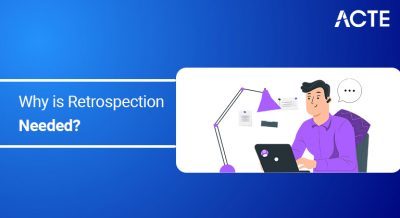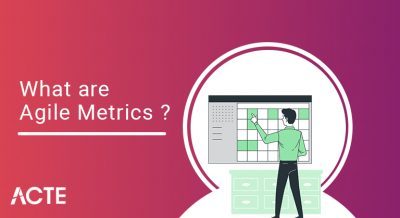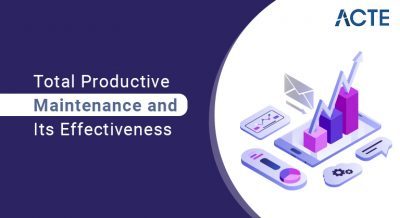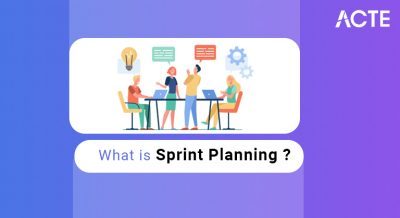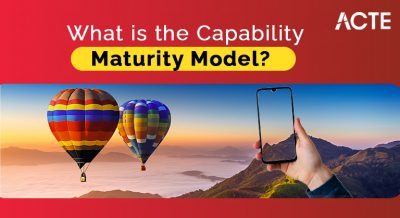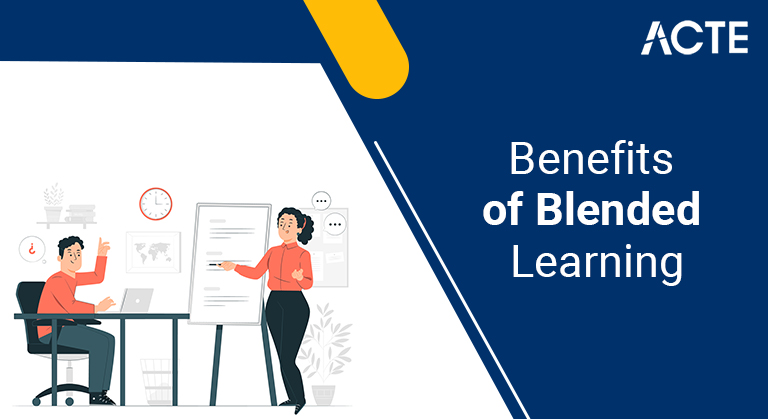
Blended learning is the term given to the educational practice of combining digital learning tools with more traditional classroom face to face teaching. In a true blended learning environment, both the student and the teacher should be physically located in the same space.
- Introduction to Blended Learning
- Blended Learning Terminology
- History of Blended Learning
- Blended Learning Models
- Specific Features of Blended Learning
- Why Is Blended Learning Important?
- Advantages of Blended Learning
- Conclusion
Introduction to Blended Learning:
ACTE defined blended learning within the past. Blended Learning may be a variety of learning methods that include multiple instruction modals–most repeatedly eLearning and traditional face-to-face learning.
Blended learning may be a genuine development to the growing accessibility of eLearning, online resources, and therefore the persisted need for a person’s part within the understanding experience. A blended learning process guarantees that the researcher is used and operating his or her educational knowledge. This process also allows cater to the special requirements of the student, most students have individual learning styles and a blended course is further likely to cater to those requirements than a traditional classroom instruction inside.
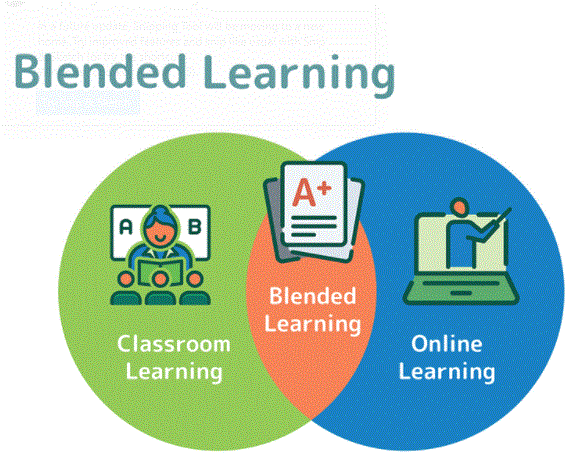
- The terms “blended learning”, hybrid learning, technology intervened education, web improved instruction, and “mixed-mode education are continually used interchangeably in the study literature.
- Although the ideas behind combined learning were first created within the 1960s, the formal terminology to describe it didn’t take its present form until the late 1990s. During a one amongst in every of”one among the earliest uses of the term occurs in a 1999 handout, during which the Interactive Learning Centers, an Atlanta-based education business, reported a change of name to EPIC Learning. The waiver states that The Company currently employs 220 online classes, but will start showing its Internet courseware utilizing the company’s Blended Learning methodology.
- In a piece titled “Defining Blended Learning”, student Norm Friesen means that, in its present form, blended learning “means the range of opportunities presented by integrating Internet and digital media with specified classroom forms that need the physical co‐presence of teacher and pupils.
- The term “blended learning” was originally vague, containing a good sort of technologies and pedagogical practices in varying blends (some making no use of technology whatsoever). In 2006, the word evolved more marked with the journal of the direct Handbook of Blended Learning by Bonk and Graham. Graham discussed the breadth and vagueness of the term’s meaning, and gave “blended learning systems” as learning strategies that “connect face-to-face teaching with computer-mediated instruction”.
Blended Learning Terminology:
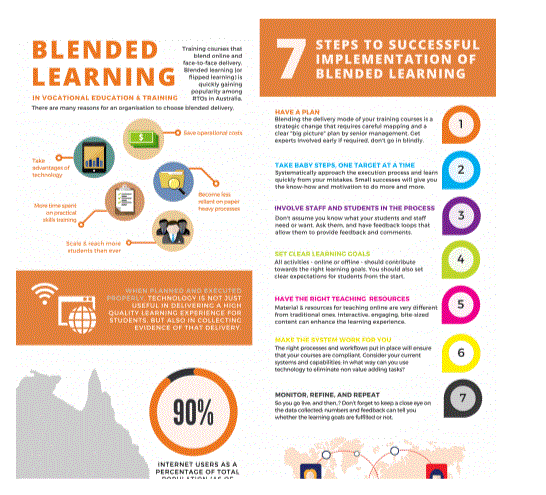
History of Blended Learning:
Technology-based training appeared as a replacement to instructor-led training within the 1960s on mainframes and mini-computers. The major benefit that blended discovering suggestions is scale, whereas one professor can only lead numerous people.
One model is PLATO (Programmed Logic for Automatic Teaching Operations), a system developed by the University of Illinois and Control Data. PLATO especially had a complete history of innovations and delivered coursework from crude to the school level. Mainframe-based training had a type of interface limitations that gave thanks to satellite-based live video within the 1970s. The advantage here was serving people that weren’t as computer literate. The main challenge was the expense needed to form this work.
In the early 1990s, CD-ROMs appeared as a prevalent sort of delivering technology-based instruction as bandwidth through 56k modems wasn’t willing to support very top-quality sound and video. The end to CD-ROMs was following completion of coursework, so performance control systems emerged as to how to allow progress tracking. The aviation industry used this laboriously to trace how well one did on courses, what balance of time was spent, and where someone left off. AICC, Aviation Industry Computer-Based Training Committee, was created in 1988, and companies like Boeing employed CD-ROMs to supply personnel training.
Contemporary blended instruction is proposed online, although CD-ROMs could feasibly still be used if a knowledge management system completes an institution’s standards. Some models of channels through which online blending education is usually delivered contain webcasting (synchronous and asynchronous) and online video (live and recorded).
Blended Learning Models:
You can read more about the different sorts of blended learning models in additional depth here. As a brief resume, know that gratefulness to its modular design, blended learning can be available in considerable shapes and sizes and be personalized to suit the person. These types of models can include: Online – Instruction occurs via a web platform, with periodic face-to-face sessions.
Rotation: Student circles between self-paced online learning and face-to-face instruction. Programs are set but adjustable.
Flex: Most education is offered online, with teachers providing as-needed help in small-group backgrounds.
Personalized blend: Trainer designs face-to-face and anywhere, anytime learning possibilities that perch the physical classroom and virtual spaces. Learning is that the standard and while is that the variable.
Online lab: Instructions take place during a brick and mortar lab. Delivered by a web teacher and managed onsite by paraprofessionals.
Self-blend: Experimenters take online courses to improve their traditional schools face to face course records.
Face-to-face: The cart shows predominantly face-to-face instruction, supplemented with technology within the classroom or computer lab.
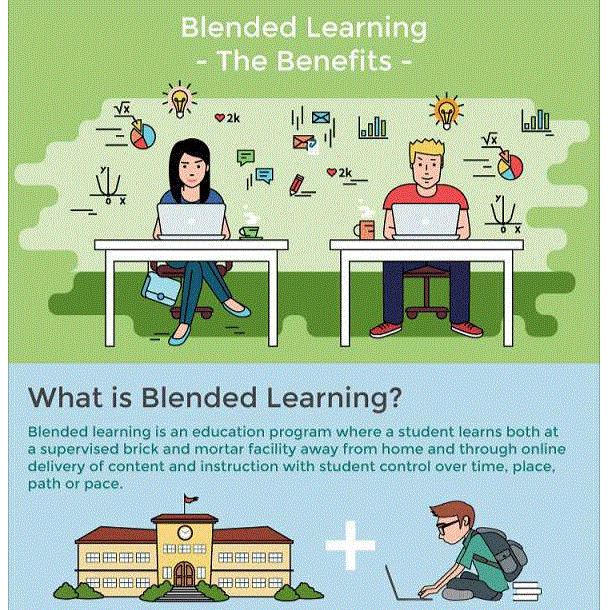
- Increased trainee engagement in learning.
- Enhanced learner and trainer interaction.
- More flexible teaching and learning environment.
- Offers 24/7 access to training resources.
- Provides personalized training experiences.
- Provides time flexibility.
- Reduction in training costs.
- Management of your time.
- More responsibility for learning.
- Increased efficiency.
- Extended reach.
- More effective.
- Covers all learning styles.
Specific Features of Blended Learning:
The elements of blended learning are its incorporation of standard sorts of teaching with dynamic and highly customized sort of learning utilizing communication and knowledge technology. Blended learning solutions has the subsequent main qualities –
Why Is Blended Learning Important?
Blended learning is significant because it dies down the regular walls of teaching, ones that don’t work for all learners, and now with a key to present-day technologies and resources, we will tailor the marks understanding for every student. Blended learning also presents relaxed time frames that will be personalized to every person, describing them the capacity to learn at their speed.
Advantages of Blended Learning:
Now that we know what blended learning is, let us get into it’s key advantages –
Flexibility – A blended learning approach provides flexibility in presenting content. Complex topics can be presented in the classroom while the others can be accessed online. With an online component, flexibility and convenience is increased over how and when the learners participate in training.
Effectiveness – Blended learning solutions has the proven potential to enhance both the effectiveness and efficiency of meaningful learning experiences. Blended learning effectiveness may be dependent on many factors such as learner characteristics, design features and learning outcomes. Learner satisfaction with a learning management system can be a preceding factor for blended learning effectiveness.
Efficiency – With a well-planned blended learning strategy, training can be delivered with limited resources and quickly to a broad audience and with digital assets such as videos, recordings and eBooks, the potential for reuse is huge. Blended learning offers an efficient way of training. It ensures that best elements of both instructor led training and online learning are implemented in the most effective way possible.
Cost effectiveness – Strategies which save money are preferred first and blended learning is one of them. Including more online options in the training program, saves on travel and missed work. A blended learning approach is more cost effective to operate and thus results in improved outcomes.
Personalization – Well crafted blended learning solutions can provide a seamless transition from classroom to computer or vice versa. Trainers can design ways of continuing discussion themes and personalizing content to a learner’s specific needs and interests. Personalizing learning can result in increased motivation and better learning outcomes.
Extended reach – Creating a blended learning strategy reduces classroom teaching time. More learners are reached out with high quality content at a minimal cost. This frees trainers to create more content.
Covers all learning styles – When designing training for adults, it is important to take learning styles into consideration. Effective blended learning is the best solution that helps to cater to all learning styles through a variety of mediums and techniques.
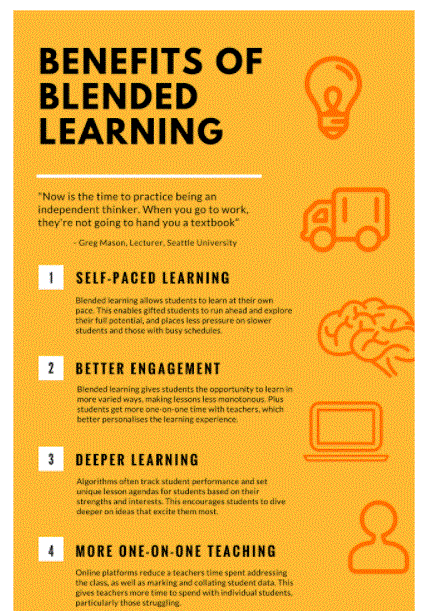
Conclusion:
A blended learning approach ensures that the learner is engaged and driving his individual learning experience. Since learners have unique learning styles, blended learning solutions is more likely to cater to their individual needs and interests. Blended learning solutions help faculty to engage with technology and just provides opportunities to promote interaction both in and out of the classroom. Blended learning helps learners to be confident, experimental and literate with digital technologies and thus go forth into an increasingly digital world.

